Product Requirements Document: What You Need To Know
A product requirements document is typically prepared by the product manager before any work is done towards product development.
It is to product development as blueprints are to construction. But while it presents many advantages to developers, one disadvantage is its complexity—writing it effectively requires experience.
So, how are you supposed to write one for the first time? To start with, you need to gain a better understanding of this document, and we can help in that regard.
Read on as we delve into a product requirements document, its significance, components, and how to write one.
Let’s start with its definition.
Table of Contents
- What is a product requirements document (PRD)?
- Why is product requirements document important?
- What is included in a product requirements document?
- How do you write a product requirements document?
- #1. Secure buy-in from key stakeholders
- #2. Gather user feedback to shape the product features
- #3. Define the objectives and scope of the product
- #4. Create detailed user personas
- #5. Document functional requirements
- #6. Document non-functional requirements
- #7. Develop use cases and user stories
- #8. Design wireframes and mockups
- #9. Address assumptions and constraints
- #10. Identify dependencies
- #11. Enumerate the acceptance criteria
- #12. Review and approval process
- 5 tips for writing an effective PRD
- Closing thoughts: product requirements document
- Machine Learning In Finance: 12 Essential Applications
- How To Create Interactive Compliance Training For Bank Employees
- How Fintech Apps Are Using Gamification To Increase User Engagement
- Top Gamification Companies for Employee & Customer Engagement
What is a product requirements document (PRD)?
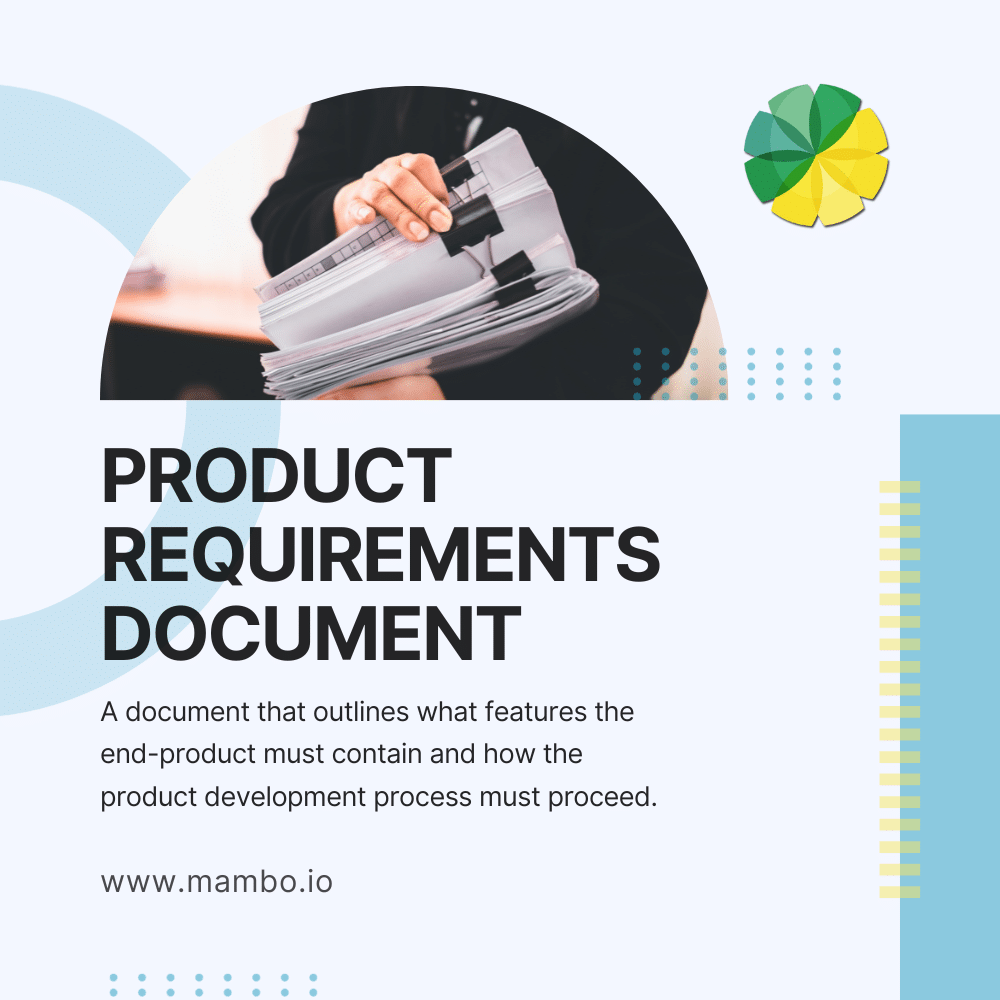
A PRD outlines the requirements of a product. It contains specific details about the product, such as the features it must contain and even the reasoning behind them.
It may vary in terms of format or content.
However, the idea remains the same—it must be a compass for the development team. It ensures they only move in the right direction, a surprisingly common problem during product development.
But aside from this rather simple purpose, its significance encompasses a larger part of product development than you would think.
Why is product requirements document important?
While the concept of a PRD may seem straightforward, its absence can lead to disastrous consequences. For one, it can hinder the product’s development.
Ultimately, this would lead to delays or even prevent its success entirely. To truly understand its significance, it’d help to explore the consequences of not having one.
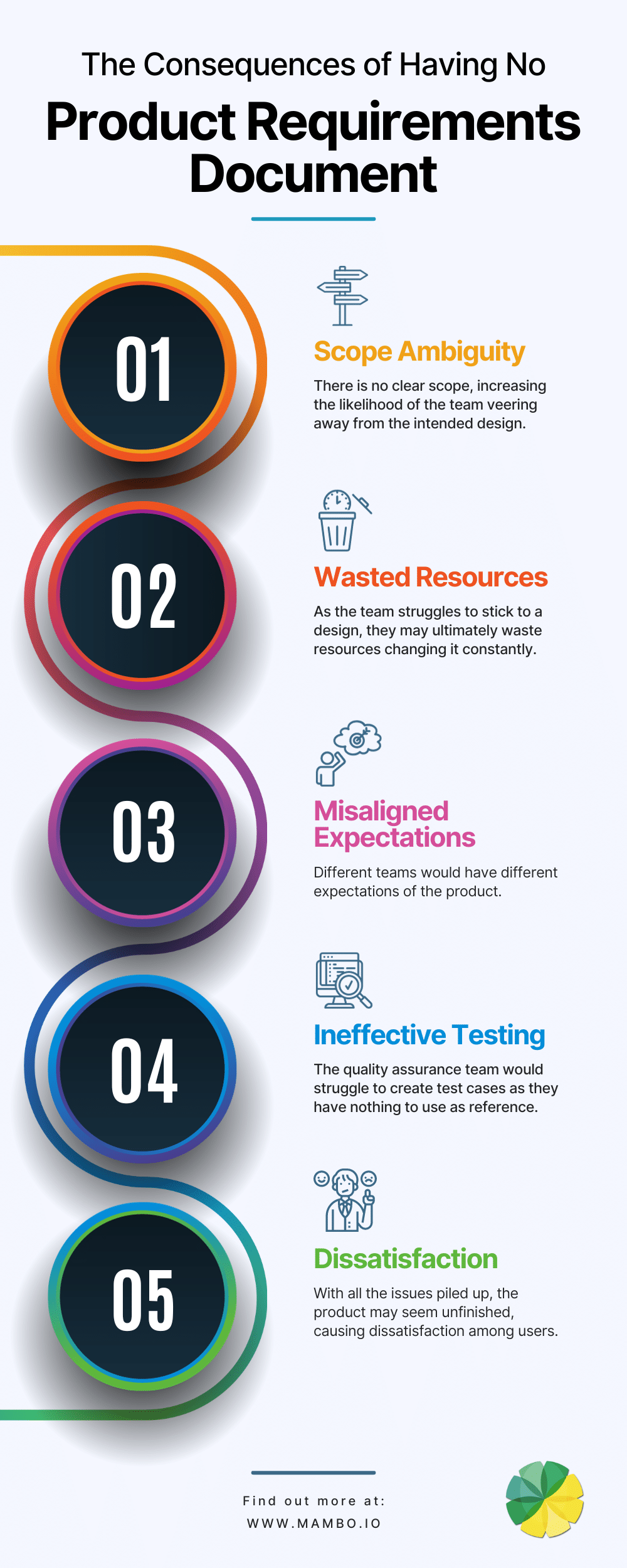
Scope ambiguity and feature creep
A PRD provides the development team and other relevant departments a concrete definition of the product requirements. With it, the scope becomes clear.
- Have we done enough for this week’s product iteration?
- Should we add a few more features before moving on?
- Is our product ready for release?
These are questions that will ultimately come up in the absence of a PRD.
Ultimately, it would lead to feature creep, where the team keeps adding product features. As a result, the timeline will extend far beyond the original schedule.
Feature creep, or having too many features in general, may also negatively affect customer satisfaction.
According to the CHAOS Report, satisfaction is often higher when the product delivers fewer features than originally specified. It shows how the development team took time to remove the lesser important features.
Wasted resources with each passing week
Adding too many features is not the only possible result of confusion from the lack of a PRD. Development teams may also get lost in the development process, prompting them to redesign components or rewrite code constantly.
This not only extends the project timeline but also ultimately increases the necessary budget for that particular product.
Misaligned expectations among team members
It is not uncommon for team members to have different expectations of a product. Suppose a company intends to create a unique mobile shopping application.
From that alone, the design team assumed the app would have a unique aesthetic, focusing primarily on its visual design. Meanwhile, the product engineers assumed it would have a technical infrastructure, efficient database management, and a robust backend.
Two teams have different expectations, which can result in them focusing on two things. Many other misunderstandings and conflicts can arise from this.
Such is the consequence of having no product or technical requirements document.
With one, there would be minimal to no debates over what the product should deliver. It gives the teams a reference point, getting everyone on the same page.
Ineffective testing and quality assurance
Most companies have both development and testing teams. The latter is responsible for creating test cases to determine if the product is up to standard.
For instance, a test case might determine whether a dropdown menu for selecting countries works as intended. Normally, the QA process is straightforward.
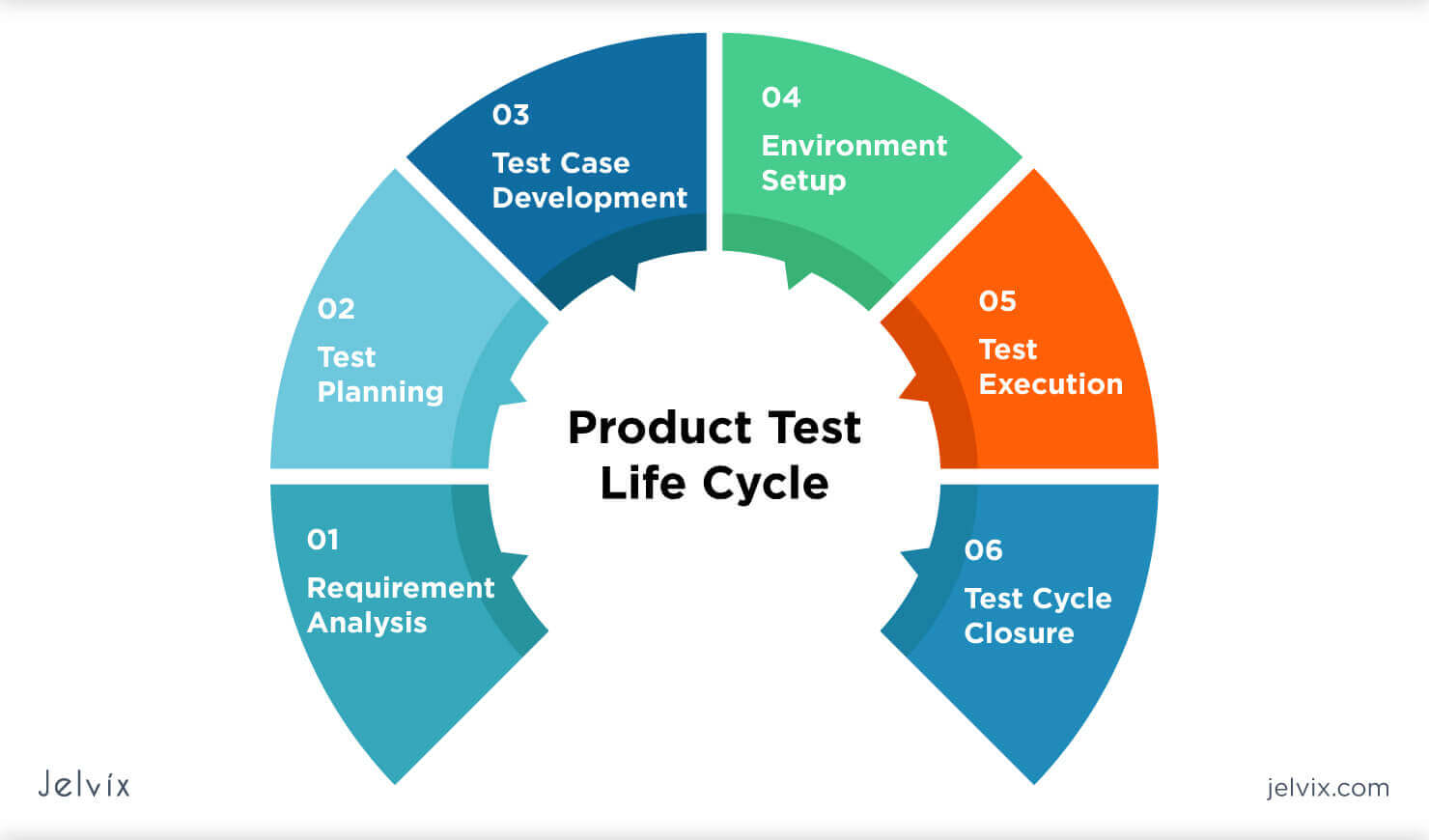
Source: Jelvix
However, it can become incredibly convoluted if they have no basis for a test case.
- Shouldn’t the list of countries update in real time as I input letters?
- Was the list supposed to be empty and only filled up once the user entered a letter?
- Was the menu supposed to collapse automatically when I click outside of it?
Confusion and guesswork become a common occurrence in the absence of a PRD.
Granted, the QA Team may eventually figure out what the product is supposed to do. But you could streamline the process with a PRD.
Disappointed customers on product launch
When facing all the issues above at once, there’s a good chance you’ll end up with an unfinished product. It’d be riddled with bugs, lacking important features, etc.
In this case, it’d be no surprise if the anticipation of customers turns to disappointment—the final nail in the coffin. In short, without a proper PRD, the business and technical teams can easily lose their way.
But then again, having a PRD doesn’t automatically prevent these issues either. After all, a messy PRD is not any more effective than not having created one in the first place.
What is included in a product requirements document?
The format of a PRD ultimately depends on the product managers. But as a point of reference, the standard format typically includes the following components:
#1. Title
Like most documents, having a title is only fitting. It gives the team a name to call the project during conversations. Though admittedly, it’s not the most important component.
#2. Version history
The version history is a rather unique component of the PRD, mostly because it changes constantly.
It outlines what important changes were made to the PRD, who, and when.
It’s important to clarify that it only outlines changes made to the document, not the product itself. Still, it’s especially useful to product managers.
#3. Overview
The overview briefly explains what the project is all about and the reasoning behind it. It also outlines the overall scope of the product, such as what it will and will not include.
#4. Requirements/features
These are the features you plan to include in the product.
It typically comes in the form of user stories that explain why it’s important to users. These user stories detail how the interaction between the feature and the end-user would take place.
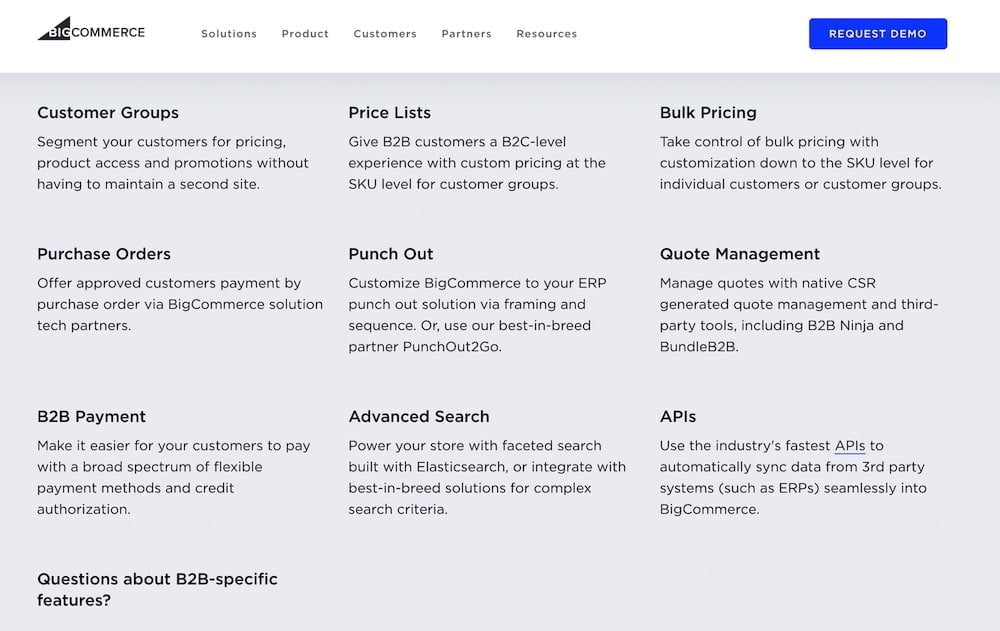
Source: BigCommerce
This section would also include the non-functional requirements. These are requirements aside from the features, such as performance, usability, and reliability.
#5. Design mockups
As the name suggests, this section is a rough draft of the product’s intended design.
It mostly pertains to the product’s visual aspect.
#6. Assumptions and constraints
This section would contain all the assumptions you have that will impact the overall structure of your product. These typically revolve around the market or your users.
For instance, if you’re creating a gamified platform, you’d assume that your users are familiar with game elements.
On the other hand, constraints are the limitations that would affect product development, such as your budget or the timeline.
#7. Dependencies
Dependencies are the relationships between external factors that may affect your product.
If you intend to use cloud hosting services, they would be an example of a dependency. Your product’s availability would depend on theirs, after all.
#8. Acceptance criteria
As stated earlier, a PRD determines whether you’ve done enough for the product development. To be precise, it decides when the right time is for a product launch.
That’s what the acceptance criteria, or release criteria, is all about.
It outlines the prerequisites that must be met before your product is fit for release.
It generally depends on the product manager how in-depth they want the PRD. Some would want a simpler document which contains only the bare minimum. Others may want a more comprehensive document that includes all the details about each part of the product.
To put it into perspective, here’s an example of a product requirements document that contains these exact components.
Regardless, these are the components the PRD should typically include. But the question remains: how should you add each of these elements to your document?
How do you write a product requirements document?
Every product manager would have their way to write a PRD. But those who lack such experience would find that having a guide, much like this one, is quite handy.
With that said, below is a list of steps you must take to efficiently write a PRD.
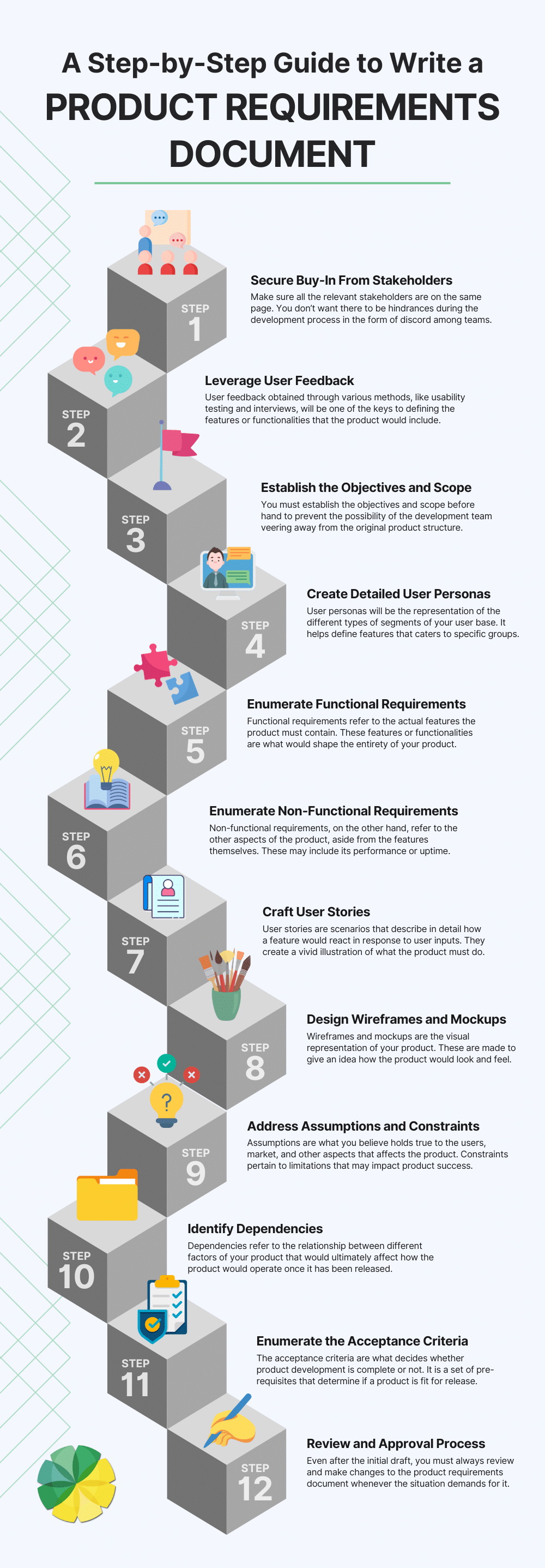
#1. Secure buy-in from key stakeholders
The contents of your product requirements document depend on the requirements of your stakeholders. As such, there’s a need to secure buy-in from them.
In this context, securing buy-in means convincing them that the core idea behind your supposed product is worth their investment.
This means you would have to first identify your key stakeholders. They would vary from project to project, but as far as product development is concerned, it often includes:
- You, the product manager.
- The development team, including the developers, engineers, and programmers.
- The designers.
- The quality assurance (QA) team.
- The marketing team.
- The sales team.
- Executives, investors, and shareholders.
#2. Gather user feedback to shape the product features
You’ve secured buy-in from key stakeholders. But as it currently is, all you have is the core idea behind your product. You need to expand what you can put into the document.
More specifically, you must decide on the features or user stories, which is the most important part. There are several ways to do so, but gathering feedback from the product’s eventual end-user is often the most advisable. You can do these through methods like:
- Usability testing.
- Surveys.
- Interviews.
Your main goal is to understand their preferences, needs, and pain points.
These would be invaluable for shaping your product’s functionality and features.
#3. Define the objectives and scope of the product
Like with any other project, you have to define your objectives. It serves as a compass for your team, ensuring you move in the right direction.
This step is when you create the overview. Often, this step involves asking yourself the following questions:
- What problems does this product aim to solve?
- Who or what kind of consumers would buy this product?
- Why is this product important?
Moreover, you must establish the scope of the product.
You need to clarify what it will and will not include. The scope is a simplified version of the list of features and excluded features.
#4. Create detailed user personas
To help craft features, it is also a common practice to create user personas.
These personas represent the different types or segments of users.
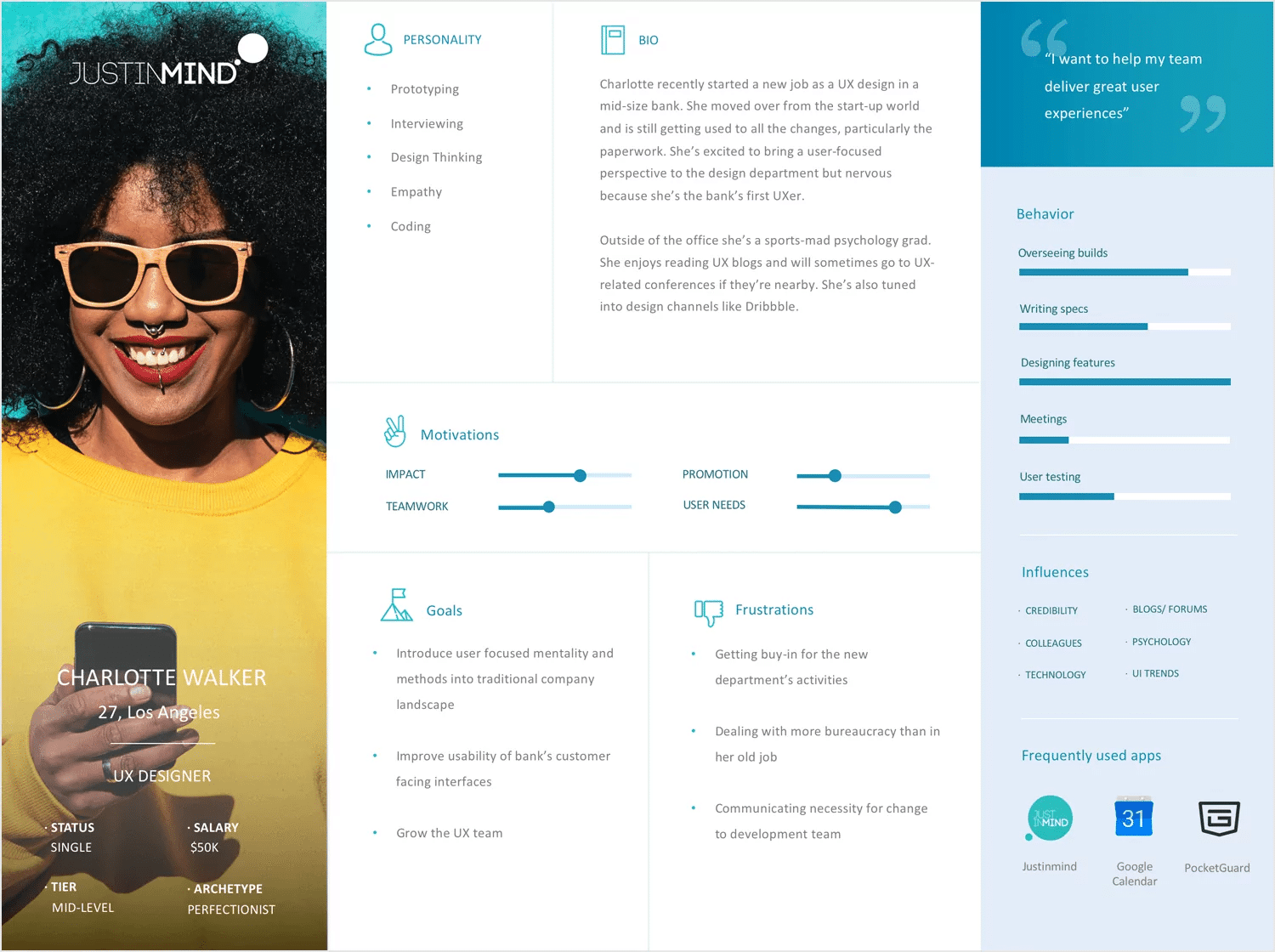
Source: UserGuiding
They can help understand the user’s needs, motivations, and behaviours. It allows you to define and design features that cater to a specific group.
For instance, let’s say you have a user persona of someone who often faces time and budget constraints. This persona emphasises the importance of an automation feature.
Other personas can point towards the importance of certain features.
#5. Document functional requirements
This step is where you write the features but in their simplest forms.
It must only include the features rather than a user story, which would be another step. For instance, let’s say your product is named TaskZenith (an imaginary product) and a task management tool. Its functional requirements would likely look like this:
- Task prioritisation: Assign different priorities to their tasks (e.g., low, medium, high).
- Task sorting: Sort tasks based on their priority.
- Notifications and alerts: Receive real-time notifications.
#6. Document non-functional requirements
You must also include plans for other aspects beyond the product’s functionality. In other words, you must address the non-functional requirements, which may include:
- Performance.
- Security.
- Legality and compliance.
- Usability.
- Reliability.
- Maintenance.
- Support.
Some examples of non-functional requirements to be included in a PRD are as follows:
- Maintenance: Security patches and software updates must be dished out monthly.
- Support: Customer support for the product would be available from 9 AM to 6 PM.
- Reliability: User data will be backed up every month.
#7. Develop use cases and user stories
In this step, you must expand what you’ve listed in the two previous steps. You must craft use cases that describe detailed scenarios of how users would interact with the features.
Let’s use our previous example product, TaskZenith, particularly its notifications and alerts functionality. Use cases that revolve around said feature would look like this:
Notifications and alerts functionality
- User story: As a user, I want to receive real-time notifications for task updates and reminders.
- User scenario #1: Users will receive a real-time notification whenever a task’s due date is coming up.
- User scenario #2: Users will receive a real-time notification whenever a task they’re sharing or shared with them is updated.
- User scenario #3: Users will be sent to the corresponding task upon clicking the notification.
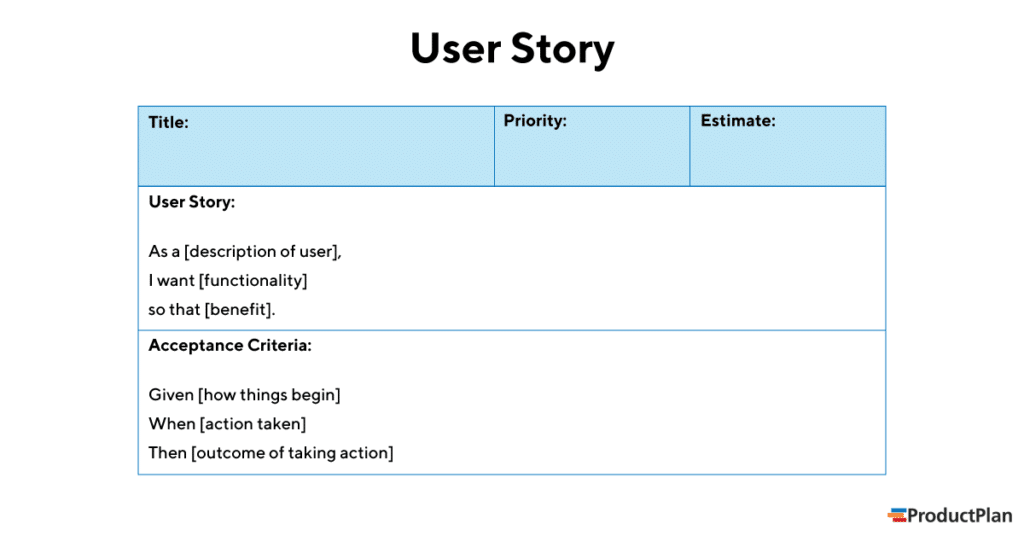
Source: ProductPlan
#8. Design wireframes and mockups
Wireframes and mockups are the visual representations of your product’s user interface.
They help convey its intended feel and look, including its navigation, layout, and other visual elements. Mockups are to be made for every part of the product.
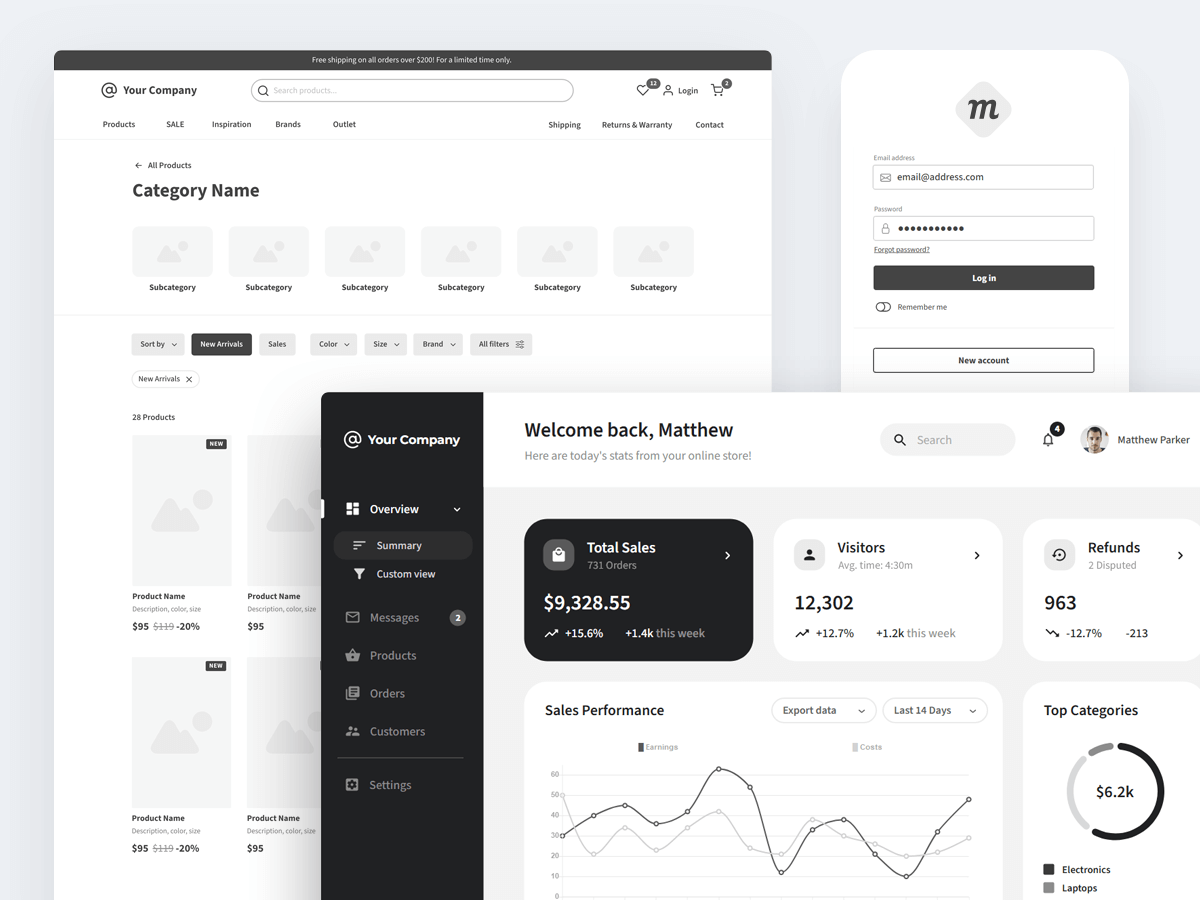
Source: moqups
For instance, in the case of TaskZenith, there would be a mockup for the following pages:
- Task list view.
- Task detail view
- Task creation popup.
- Notifications centre.
- Error pages.
#9. Address assumptions and constraints
Like with any project, there would be assumptions made that will define certain aspects of the product. For instance, assume the users would have reliable internet connectivity. As such, offline access will not be within this project’s scope.
Another assumption is that the user base will be at most 10,000 concurrent users. For that reason, scalability in terms of handling user load beyond this point would be for the future.
In addition to assumptions, you must also address constraints. Some examples include:
- Budget constraints: The project operates within a strict budget, so certain features that would be handy might be left out.
- Timeline constraints: Similarly, due to time constraints, certain features that are too complex would be deferred to future releases.
- Legal regulations: The product must comply with data privacy regulations, so any changes in these regulations would require updates.
#10. Identify dependencies
Dependencies pertain to the relationships between components or factors impacting the project’s timeline or overall success. Identifying your dependencies is necessary to ensure proper planning, risk management, and resource allocation.
The keyword here is depend.
Here are some examples of dependencies for our example product, TaskZenith:
- Third-party integrations: Since TaskZenith would rely on cloud-hosting services, the platform’s uptime would depend heavily on the provider’s availability. To address potential concerns, establishing strong communication with them is necessary.
- Data privacy compliance: Our methods of data collection and processing would depend heavily on existing data privacy regulations like GDPR.
- Quality assurance: The timeline for quality assurance will “depend” on the completion of the development tasks. It will not begin until the necessary milestones are reached. Test cases would also depend on the existing functional requirements.
#11. Enumerate the acceptance criteria
The acceptance criteria refer to the conditions that must be met before a project is considered done. These conditions are often exclusive to specific parts of the product.
In some cases, this section would also outline how the team must verify the criteria.
Consider the following examples:
- Acceptance criteria #1: Users can create tasks enter a title and description, and set the category and due date. Verification may involve double-checking that these fields are present during task creation.
- Acceptance criteria #2: Users can assign a priority level to each task. Verification may involve checking if it is truly possible to set the priority level. Moreover, it must be visually represented properly on the corresponding task card.
It’s also not unusual to include the KPIs that would measure product success here, a.k.a. the success metrics. Examples of such KPIs are user engagement rate and retention rate.
#12. Review and approval process
Once the PRD has been written, it must be shared with the participants, which typically includes:
- You, the product manager.
- The design team.
- The development team.
- The quality assurance team.
Within a few days, they would provide feedback, questions, or comments regarding the PRD. The product manager must then consolidate the feedback and make the appropriate changes. Only with a reviewed PRD would it go to the key stakeholders.
Once the stakeholders approve of the PRD, development will start. Any changes made to the PRD during this time would go to the version history section of the document.
Again, there are different ways to approach the writing process of a product requirements document. The best approach for your team may not necessarily require some of the steps here. However, some tips are handy regardless of your step-by-step process.
5 tips for writing an effective PRD

#1. Use simple and unambiguous language and avoid technical jargon
Because a PRD is often associated with product development, it’s common to use technical jargon.
You must remember that you’d eventually have to share the document with stakeholders, some of whom may lack technical knowledge. As such, using unambiguous and simple language is common practice to avoid confusion.
#2. Ensure consistency in formatting and terminology
To further improve readability, it also helps to use a structured format. Take advantage of formatting tools like headings, subheadings, and bullet points.
In addition, when using a rather specific term, stick to that terminology throughout the entire document. If you use the term “user,” for example, then keep using that until the end. Do not alternate between different terms, like client or customer.
#3. Utilise tools and templates
There must already be PRD templates available either on your company’s knowledge base or online. If so, don’t shy away from using these templates.

Source: ClickUp
The same can be said for having a dedicated requirements management tool. If you believe it would streamline the writing process of your product requirements document, go for it.
#4. Collaborate with stakeholders and cross-functional teams
Throughout the writing process of this document, you must collaborate with the relevant stakeholders. That may include the developers, executives, and designers.
That way, you can ensure everyone’s input has been considered.
#5. Keep the document up-to-date
Much like the product itself, your PRD would need to be regularly updated to reflect changes over time. After all, user needs and market demands may change over time.
Consider this example:
Before product development, you found that your target audience prefers text-based communication. However, their interest shifted to real-time voice features during development. In this case, it would be necessary to update the user stories accordingly.
Closing thoughts: product requirements document
A document may seem insignificant in the grand scheme, but a PRD is not just any document. The product requirements document defines how the product development process would go. It also outlines the final product’s features, among many things. But as important as it may be, writing is often as difficult.
It takes a lot of experience and knowledge of the document. If you lack such experience, this guide should compensate by providing you with the necessary knowledge.
If your product involves gamification, consider including an on-premise or SaaS gamification solution as part of your PRD. Request a demo with Mambo now and find out how we can streamline the implementation of gamification features to your product.
Download your free
“Gamification Guide”
Get your PDF now and start transforming your approach to digital engagement!
Latest Posts
Machine Learning In Finance: 12 Essential Applications
The impact of machine learning on finance is significant. Thanks to this technology, financial institutions are now equipped to make efficient decisions. Through the analysis of data sets, machine learning […]
How To Create Interactive Compliance Training For Bank Employees
Banking compliance training isn’t just another task. It’s the stage where everything else performs. Banks must navigate a myriad of regulations and laws. After all, this is a trust-driven, high-stakes […]
How Fintech Apps Are Using Gamification To Increase User Engagement
Discover how gamification in fintech is revolutionizing financial engagement, making banking fun & boosting user loyalty.





